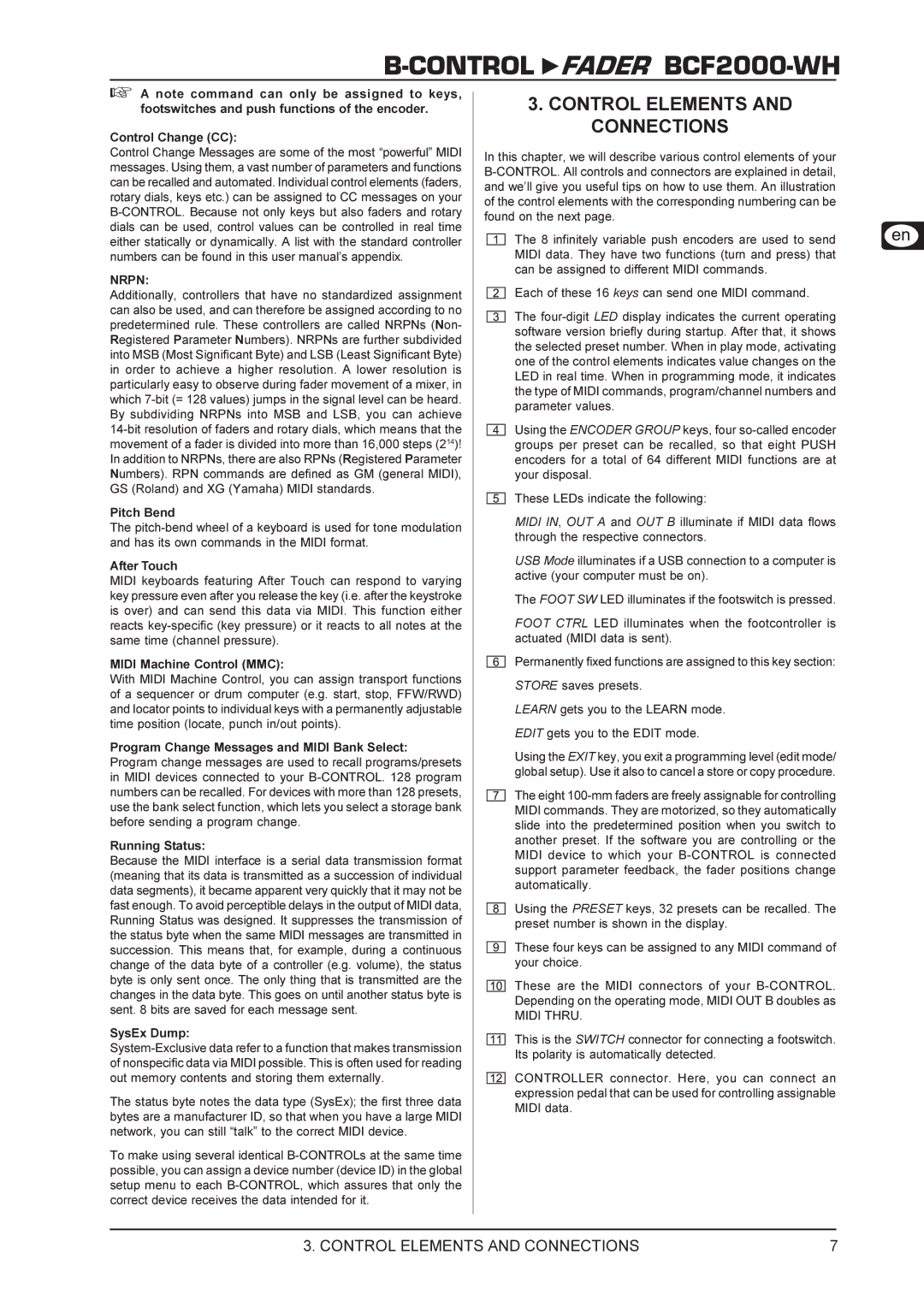
B-CONTROL  FADER
FADER BCF2000-WH
+A note command can only be assigned to keys, footswitches and push functions of the encoder.
Control Change (CC):
Control Change Messages are some of the most “powerful” MIDI messages. Using them, a vast number of parameters and functions can be recalled and automated. Individual control elements (faders, rotary dials, keys etc.) can be assigned to CC messages on your
NRPN:
Additionally, controllers that have no standardized assignment can also be used, and can therefore be assigned according to no predetermined rule. These controllers are called NRPNs (Non- Registered Parameter Numbers). NRPNs are further subdivided into MSB (Most Significant Byte) and LSB (Least Significant Byte) in order to achieve a higher resolution. A lower resolution is particularly easy to observe during fader movement of a mixer, in which
Pitch Bend
The
After Touch
MIDI keyboards featuring After Touch can respond to varying key pressure even after you release the key (i.e. after the keystroke is over) and can send this data via MIDI. This function either reacts
MIDI Machine Control (MMC):
With MIDI Machine Control, you can assign transport functions of a sequencer or drum computer (e.g. start, stop, FFW/RWD) and locator points to individual keys with a permanently adjustable time position (locate, punch in/out points).
Program Change Messages and MIDI Bank Select: Program change messages are used to recall programs/presets in MIDI devices connected to your
Running Status:
Because the MIDI interface is a serial data transmission format (meaning that its data is transmitted as a succession of individual data segments), it became apparent very quickly that it may not be fast enough. To avoid perceptible delays in the output of MIDI data, Running Status was designed. It suppresses the transmission of the status byte when the same MIDI messages are transmitted in succession. This means that, for example, during a continuous change of the data byte of a controller (e.g. volume), the status byte is only sent once. The only thing that is transmitted are the changes in the data byte. This goes on until another status byte is sent. 8 bits are saved for each message sent.
SysEx Dump:
The status byte notes the data type (SysEx); the first three data bytes are a manufacturer ID, so that when you have a large MIDI network, you can still “talk” to the correct MIDI device.
To make using several identical
3.CONTROL ELEMENTS AND CONNECTIONS
In this chapter, we will describe various control elements of your
The 8 infinitely variable push encoders are used to send MIDI data. They have two functions (turn and press) that can be assigned to different MIDI commands.
Each of these 16 keys can send one MIDI command.
The
Using the ENCODER GROUP keys, four
These LEDs indicate the following:
MIDI IN, OUT A and OUT B illuminate if MIDI data flows through the respective connectors.
USB Mode illuminates if a USB connection to a computer is active (your computer must be on).
The FOOT SW LED illuminates if the footswitch is pressed.
FOOT CTRL LED illuminates when the footcontroller is actuated (MIDI data is sent).
Permanently fixed functions are assigned to this key section:
STORE saves presets.
LEARN gets you to the LEARN mode.
EDIT gets you to the EDIT mode.
Using the EXIT key, you exit a programming level (edit mode/ global setup). Use it also to cancel a store or copy procedure.
The eight
Using the PRESET keys, 32 presets can be recalled. The preset number is shown in the display.
These four keys can be assigned to any MIDI command of your choice.
These are the MIDI connectors of your
MIDI THRU.
This is the SWITCH connector for connecting a footswitch. Its polarity is automatically detected.
CONTROLLER connector. Here, you can connect an expression pedal that can be used for controlling assignable MIDI data.
3. CONTROL ELEMENTS AND CONNECTIONS | 7 |
